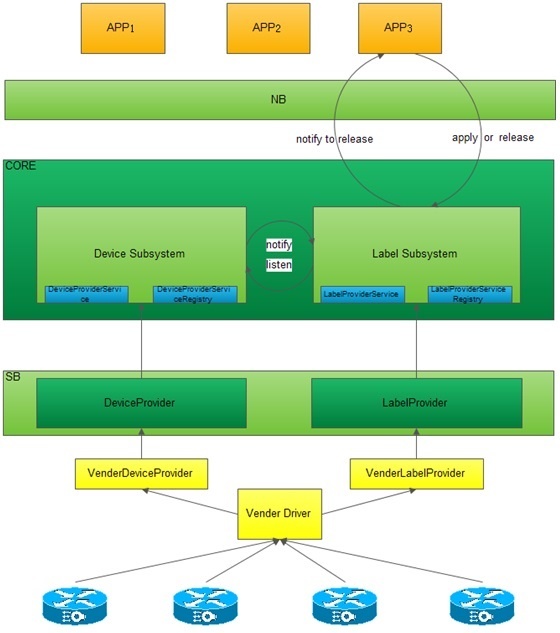
Label Subsystem
Overview
The label subsystem is designed to support MPLS-based applications. As a system resource, label is managed in ONOS and applications can acquire or release label resources through northbound API calls. The labels are constructed as resource pools and saved in ONOS stores. The label pool is a kind of container. Labels in the pools are defined as consecutive numbers. Depending on the type of applications and their specific requirements, two kinds of label pools are provided. The first one, device-label-pool, is provided by device itself when a device is connected to the network. The other one, global-label-pool, is created manually. User application can take the global-label-pool as a special device-label pool via a virtual device identity named “global_resource_pool_device_id”.
Device-label-pool and global-label-pool can co-exist in ONOS stores with different label ranges. So the label ranges in each pool should be carefully planned when operator starts deploying ONOS in their networks.
Two sets of corresponding APIs are provided to operate on these two types of pools in ONOS. The CLI commands are also implemented to access the label stores.
The following figure shows the label subsystem architecture.

WorkFlow:
Featuring:
Programming APIs for ONOS applications
The labels are provided in ONOS as a common system resource. Independent applications use the label resource through calling ONOS northbound APIs.
Meanwhile, ONOS provides southbound label APIs for device driver to communicate with ONOS.
There are two ways to create a device’s initial label resource pool, i.e., device upload and admin planned. Firstly, a device driver can call southbound API deviceLabelResourcePoolDetected to upload its local labels to ONOS. The other way is by planning labels when deploying ONOS. After planned label ranges for each device, the network administrative application calls northbound API createDevicePool to create label pool for the device. The admin planned labels will overwrite any reported labels from device. The global labels are always created by admin application via calling createGlobalPool.
Once the label pools are created, customer applications can use the label resource via calling ONOS’s northbound APIs. An applications calls getDeviceLabelResourcePool to get the device label resource pool, or getGlobalLabelResourcePool to get the global label resource pool, then call applyFromDevicePool or applyFromGlobalPool to require label from the device label pool or global label pool. Before requiring a label, application has chance to check label resource’s status in ONOS. For example, calling isDevicePoolFull to check is there is any labels available in the pool, or calling getFreeNumOfDevicePool to get current unused labels in the pool. After using the labels, application should return the labels to ONOS label pool by calling releaseToDevicePool or releaseToGlobalPool.
The followings list current APIs available in ONOS.
Southbound APIs
LabelResourceProviderService
Northbound APIs
LabelResourceAdminService
LabelResourceService
Label management CLI commands
Besides APIs, ONOS provides CLI commands for label usage and management purpose. Administrators can use CLI commands to interact with the inventory of label resource pools. Currently ONOS supports the following CLI commands: